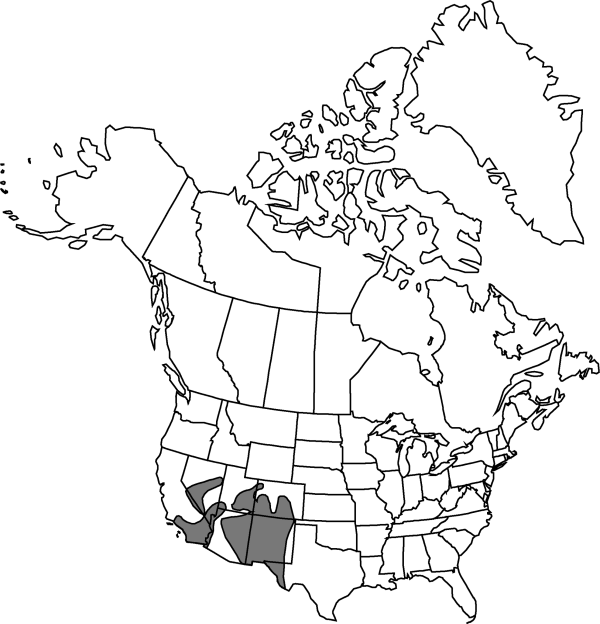Difference between revisions of "Mirabilis multiflora"
in W. H. Emory, Rep. U.S. Mex. Bound. 2(1): 173. 1859.
FNA>Volume Importer |
RevisionBot (talk | contribs) m (Bot: Adding category Revised Since Print) |
||
| (4 intermediate revisions by 3 users not shown) | |||
| Line 1: | Line 1: | ||
{{Treatment/ID | {{Treatment/ID | ||
|accepted_name=Mirabilis multiflora | |accepted_name=Mirabilis multiflora | ||
| − | |accepted_authority=(Torrey) A. Gray | + | |accepted_authority=(Torrey) A. Gray |
|publications={{Treatment/Publication | |publications={{Treatment/Publication | ||
|title=in W. H. Emory, Rep. U.S. Mex. Bound. | |title=in W. H. Emory, Rep. U.S. Mex. Bound. | ||
| Line 8: | Line 8: | ||
}} | }} | ||
|common_names=Colorado four-o’clock;Froebel’s four-o’clock | |common_names=Colorado four-o’clock;Froebel’s four-o’clock | ||
| + | |special_status={{Treatment/ID/Special_status | ||
| + | |code=F | ||
| + | |label=Illustrated | ||
| + | }} | ||
|basionyms={{Treatment/ID/Basionym | |basionyms={{Treatment/ID/Basionym | ||
|name=Oxybaphus multiflorus | |name=Oxybaphus multiflorus | ||
| Line 30: | Line 34: | ||
-->{{Treatment/Body | -->{{Treatment/Body | ||
| − | |distribution= | + | |distribution=Ariz.;Calif.;Colo.;N.Mex.;Nev.;Tex.;Utah;n Mexico. |
|discussion=<p>Varieties 3 (3 in the flora).</p><!-- | |discussion=<p>Varieties 3 (3 in the flora).</p><!-- | ||
--><p>G. E. Pilz (1978) recognized three partially sympatric varieties based on presence or absence of mucilage production in the fruits, fruit color, and apical acuteness of involucral bracts. Overall, populations are poorly differentiated, and in some areas plants represent a “collage” (Pilz’s term) that combine characteristics of different varieties; S. L. Welsh et al. (1987) recognized no varieties. <i>Mirabilis multiflora</i> is used in the Southwest in a minor way in xeriscapes. Among indigenous peoples, it has been used as food and medicine (V. L. Bohrer 1975; L. S. M. Curtin 1947).</p> | --><p>G. E. Pilz (1978) recognized three partially sympatric varieties based on presence or absence of mucilage production in the fruits, fruit color, and apical acuteness of involucral bracts. Overall, populations are poorly differentiated, and in some areas plants represent a “collage” (Pilz’s term) that combine characteristics of different varieties; S. L. Welsh et al. (1987) recognized no varieties. <i>Mirabilis multiflora</i> is used in the Southwest in a minor way in xeriscapes. Among indigenous peoples, it has been used as food and medicine (V. L. Bohrer 1975; L. S. M. Curtin 1947).</p> | ||
| Line 63: | Line 67: | ||
-->{{#Taxon: | -->{{#Taxon: | ||
name=Mirabilis multiflora | name=Mirabilis multiflora | ||
| − | |authority=(Torrey) A. Gray | + | |authority=(Torrey) A. Gray |
|rank=species | |rank=species | ||
|parent rank=section | |parent rank=section | ||
| Line 69: | Line 73: | ||
|basionyms=Oxybaphus multiflorus | |basionyms=Oxybaphus multiflorus | ||
|family=Nyctaginaceae | |family=Nyctaginaceae | ||
| − | |distribution= | + | |distribution=Ariz.;Calif.;Colo.;N.Mex.;Nev.;Tex.;Utah;n Mexico. |
|reference=None | |reference=None | ||
|publication title=in W. H. Emory, Rep. U.S. Mex. Bound. | |publication title=in W. H. Emory, Rep. U.S. Mex. Bound. | ||
|publication year=1859 | |publication year=1859 | ||
| − | |special status= | + | |special status=Illustrated |
| − | |source xml=https:// | + | |source xml=https://bitbucket.org/aafc-mbb/fna-data-curation/src/2e0870ddd59836b60bcf96646a41e87ea5a5943a/coarse_grained_fna_xml/V4/V4_84.xml |
|genus=Mirabilis | |genus=Mirabilis | ||
|section=Mirabilis sect. Quamoclidion | |section=Mirabilis sect. Quamoclidion | ||
| Line 80: | Line 84: | ||
}}<!-- | }}<!-- | ||
| − | -->[[Category:Treatment]][[Category:Mirabilis sect. Quamoclidion]] | + | --> |
| + | |||
| + | [[Category:Treatment]] | ||
| + | [[Category:Mirabilis sect. Quamoclidion]] | ||
| + | [[Category:Revised Since Print]] | ||
Latest revision as of 17:03, 6 November 2020
Herbs, forming hemispheric clumps 6–10 dm diam., glabrous or densely pubescent. Stems 4–7 dm. Leaves spreading; petioles of proximal leaves 2–4 cm; blades of midstem leaves ovate to widely ovate, sometimes suborbiculate, rarely reniform, 5–10 × 4–8 cm, base rounded to cordate, often asymmetric, apex acute or acuminate to obtuse, rarely rounded. Involucres: peduncle 4–75 mm; involucres erect or ascending, 33–35 mm; bracts 5, usually more than 50% connate, apex acute to obtuse or ovate. Flowers 6 per involucre; perianth magenta, funnelform, 2.5–6 cm. Fruits brown to black, with 10 slender, tan ribs alternating with 10 dark brown ribs, or ribs inconspicuous, ovoid or globose, 6–11 mm, smooth to rugulose, glabrous or pubescent, secreting mucilage or not when wetted. 2n = 66.
Distribution

Ariz., Calif., Colo., N.Mex., Nev., Tex., Utah, n Mexico.
Discussion
Varieties 3 (3 in the flora).
G. E. Pilz (1978) recognized three partially sympatric varieties based on presence or absence of mucilage production in the fruits, fruit color, and apical acuteness of involucral bracts. Overall, populations are poorly differentiated, and in some areas plants represent a “collage” (Pilz’s term) that combine characteristics of different varieties; S. L. Welsh et al. (1987) recognized no varieties. Mirabilis multiflora is used in the Southwest in a minor way in xeriscapes. Among indigenous peoples, it has been used as food and medicine (V. L. Bohrer 1975; L. S. M. Curtin 1947).
Selected References
None.
Lower Taxa
Key
| 1 | Fruits tuberculate, mucilaginous when wetted; involucral bracts obtuse | Mirabilis multiflora var. glandulosa |
| 1 | Fruits smooth to slightly tuberculate, not mucilaginous when wetted; involucral bracts acute | > 2 |
| 2 | Fruits dark brown to black, ribs inconspicu- ous | Mirabilis multiflora var. multiflora |
| 2 | Fruits light brown, with 10 slender, tan, longitudinal ribs alternating with 10 brown, often interrupted ribs. | Mirabilis multiflora var. pubescens |